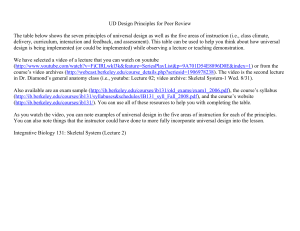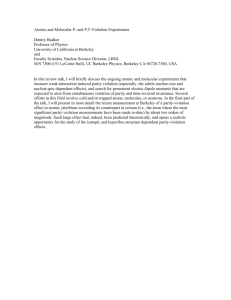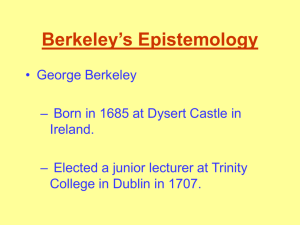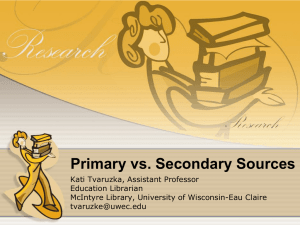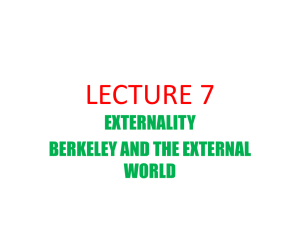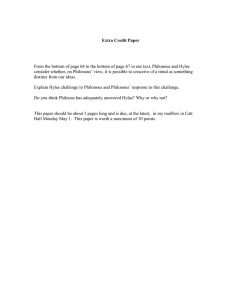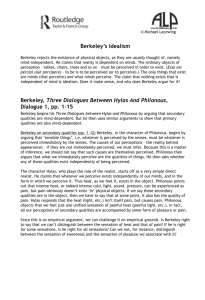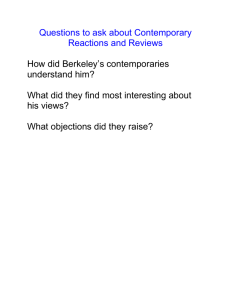Berkeley
advertisement
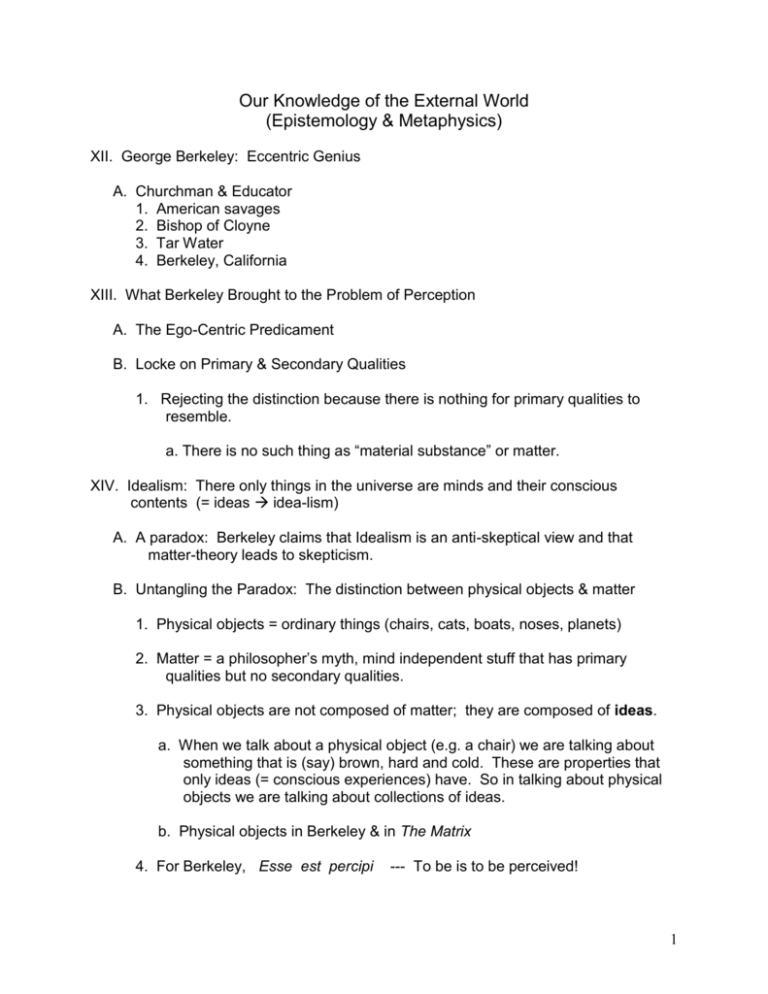
Our Knowledge of the External World (Epistemology & Metaphysics) XII. George Berkeley: Eccentric Genius A. Churchman & Educator 1. American savages 2. Bishop of Cloyne 3. Tar Water 4. Berkeley, California XIII. What Berkeley Brought to the Problem of Perception A. The Ego-Centric Predicament B. Locke on Primary & Secondary Qualities 1. Rejecting the distinction because there is nothing for primary qualities to resemble. a. There is no such thing as “material substance” or matter. XIV. Idealism: There only things in the universe are minds and their conscious contents (= ideas idea-lism) A. A paradox: Berkeley claims that Idealism is an anti-skeptical view and that matter-theory leads to skepticism. B. Untangling the Paradox: The distinction between physical objects & matter 1. Physical objects = ordinary things (chairs, cats, boats, noses, planets) 2. Matter = a philosopher’s myth, mind independent stuff that has primary qualities but no secondary qualities. 3. Physical objects are not composed of matter; they are composed of ideas. a. When we talk about a physical object (e.g. a chair) we are talking about something that is (say) brown, hard and cold. These are properties that only ideas (= conscious experiences) have. So in talking about physical objects we are talking about collections of ideas. b. Physical objects in Berkeley & in The Matrix 4. For Berkeley, Esse est percipi --- To be is to be perceived! 1 XV. An Avalanche of Arguments Against Matter A. Hylas (Matter) vs. Philonous (The Lover of Mind) 1. The ground rules of the debate: Whoever can avoid skepticism wins. B. Against Naïve Representationalism 1. Pain resembles nothing in its cause 2. Locke’s variance argument C. Hylas changes gear (& becomes a spokesman for Locke’s philosophy) D. Philonous goes on the attack against Locke 1. Variance again – this time applied to shape, motion & other (alleged) primary qualities. 2. Material substance is inconceivable: It makes no sense to think there can be objects with primary qualities but with no secondary qualities at all. 3. The Lockean notion of resemblance is absurd – only an idea can resemble an idea. E. Hylas’ last gasp: Perhaps matter exists, though we can’t know anything about it. 1. Philonous’ two replies: a. God is not untidy b. This view leads to skepticism. If chairs are made of matter, and we can’t know anything about matter, then we can’t know anything about the properties of chairs. XVI. The Problem of Unperceived Objects A. Why unperceived objects are a problem for Berkeley B. Berkeley’s first response: We don’t really think there are unperceived objects, since as soon as we think about such an object, we have an idea of it. 1. Objection: This conflates perceptions with other sorts of ideas. C. Berkeley’s second (and much more powerful) response: A new argument for the 2 existence of God. 1. It has already been argued that physical objects are made up of ideas. 2. We are confident that physical objects exist when no human (or animal) mind is perceiving them. 3. So we should be equally confident that some other mind is perceiving them: God’s mind! XVII. Berkeley on the Causes of Perception A. Berkeley agrees with Locke that our perceptions are not under our own control and must be caused by something independent of our minds. B. But perceptions are not caused by matter, since matter does not exist. C. Only a mind can cause an idea. So our perceptions must be caused by God’s mind. XVIII. Thinking through the similarities & differences between Berkeley’s account of reality and the account in The Matrix. A. The causes of perception B. What physical things are made of C. What people are made of D. How would Berkeley argue against the account of reality in The Matrix ? Epistemology & Metaphysics After Berkeley XIX. The link between epistemology (the theory of knowledge) and metaphysics (the theory of the basic components of reality). A. To say explain how we can know the world, philosophers must also explain what the world is like. XX. What has happened in the last 250 years? A. Sophisticated versions of Idealism vs. Sophisticated variations on Lockean “realism” – a debate that continues to the present. 3 B. Kant (1724-1804): A hybrid view in which parts of the reality we experience is contributed by the mind and parts are not. 1. For Kant, the mind contributes space, time and causality. 4


